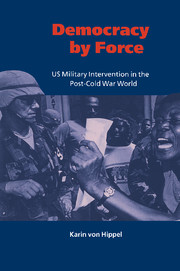Book contents
- Frontmatter
- Contents
- List of maps
- Acknowledgements
- List of abbreviations
- 1 Introduction: dangerous hubris
- 2 Invasion or intervention? Operation Just Cause
- 3 Disappointed and defeated in Somalia
- 4 Heartened in Haiti
- 5 UNPROFOR, IFOR and SFOR: can peace be FORced on Bosnia?
- 6 Hubris or progress: can democracy be forced?
- Bibliography
- Index
3 - Disappointed and defeated in Somalia
Published online by Cambridge University Press: 22 September 2009
- Frontmatter
- Contents
- List of maps
- Acknowledgements
- List of abbreviations
- 1 Introduction: dangerous hubris
- 2 Invasion or intervention? Operation Just Cause
- 3 Disappointed and defeated in Somalia
- 4 Heartened in Haiti
- 5 UNPROFOR, IFOR and SFOR: can peace be FORced on Bosnia?
- 6 Hubris or progress: can democracy be forced?
- Bibliography
- Index
Summary
UNOSOM I, Operation Restore Hope and UNOSOM II – which together endured from April 1992 to March 1995 – plunged the international community headlong into its first post-Cold War encounter with a collapsed state. For US President George Bush, still heady from his victories in the Cold and Gulf Wars (and to a lesser extent, in Panama), and UN Secretary-General Boutros Boutros-Ghali, eager to test the potential of an organisation that had been in a Superpower stranglehold since its inception, Somalia provided the perfect opportunity. Vietnam was by then a mere after-thought. The intervention in Somalia, however, did not live up to expectations. Much of Somalia today has slipped back into the situation of sporadic lawlessness that prevailed before foreign troops arrived – albeit not the famine – despite the enormous infusion of funds ($2.3 billion spent by the US government, and $1.64 billion by the UN), and invasion of untold numbers of aid workers and foreign soldiers (close to 50,000 troops at its peak).
The Somalia intervention set in motion the recent evolution of the non-interventionary norm and established a pattern in the ‘new world order’, because the decision to use military force was justified purely on humanitarian grounds. There were no strategic, economic or narco-interests that propelled the UN and the United States into action, nor foreign territory that had been invaded or seized by an errant state.
- Type
- Chapter
- Information
- Democracy by ForceUS Military Intervention in the Post-Cold War World, pp. 55 - 91Publisher: Cambridge University PressPrint publication year: 1999



